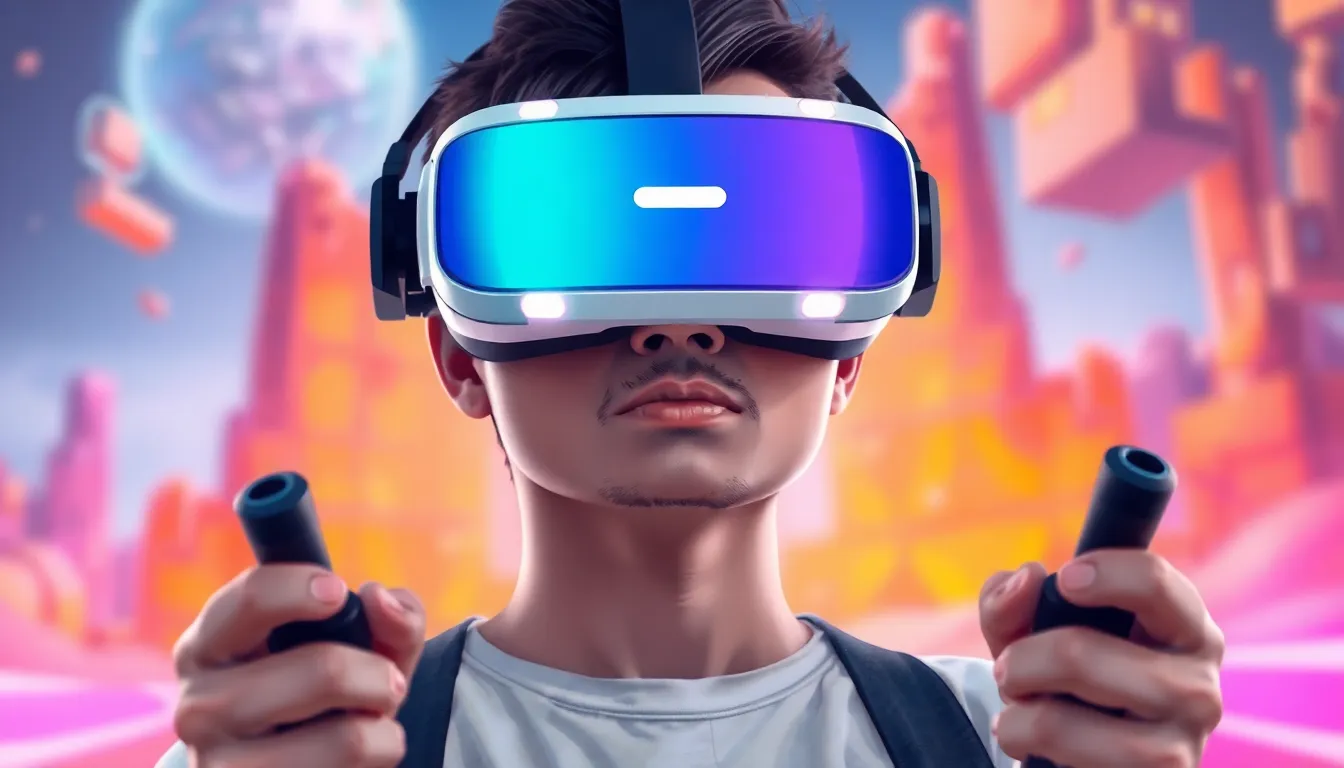Table of Contents
ToggleImagine diving headfirst into a world where dragons roam and your couch transforms into a spaceship. Immersive gaming isn’t just a pastime; it’s an experience that pulls players into vibrant universes where they can be heroes, villains, or anything in between. Forget about merely pressing buttons; it’s time to feel the adrenaline rush of sword fights and the thrill of racing through neon-lit streets.
As technology advances, so does the art of storytelling in gaming. Developers are crafting experiences that engage all senses, making players forget they’re in their living rooms. From virtual reality headsets to interactive narratives, immersive gaming offers a playground for imagination. So, grab your controller and prepare for an adventure that’s not just played but lived.
Understanding Immersive Gaming
Immersive gaming captivates players by creating rich, interactive environments. It signifies a shift from traditional gaming, where players passively engage, to a realm where they actively participate in dynamic stories.
Definition of Immersive Gaming
Immersive gaming encompasses experiences that absorb players into vividly rendered worlds. Virtual reality headsets, augmented reality applications, and advanced graphics play pivotal roles. Engaging narratives and interactive elements further enhance immersion. Players become part of the story, influencing outcomes through their choices and actions. As a result, the experience blurs the line between reality and fiction, making gaming feel more impactful and personal.
Key Elements of Immersive Experiences
Several elements contribute to immersive gaming experiences. High-quality graphics create visually stunning worlds that draw players in. Sound design enhances engagement by providing realistic audio cues. Interactivity allows players to manipulate environments and make choices that shape gameplay. Narrative depth strengthens emotional connections, involving players in the storyline. Lastly, multiplayer features foster social interactions, enabling collaboration and competition among players. These elements coalesce to form an immersive landscape that engages all senses.
Types of Immersive Gaming

Immersive gaming encompasses various forms, each enhancing player experiences in unique ways. Key types include Virtual Reality (VR), Augmented Reality (AR), and Mixed Reality (MR), all contributing significantly to the evolution of gaming.
Virtual Reality (VR) Gaming
Virtual Reality gaming allows players to enter fully-realized digital worlds using headsets. Players can interact with these environments through motion sensors and controllers, creating intense feelings of presence. Popular VR titles like “Beat Saber” and “Half-Life: Alyx” demonstrate how realistic graphics and sound design elevate immersion. By fully enclosing players in 360-degree worlds, VR transforms gaming into a sensory adventure, where exploration and interaction feel incredibly lifelike.
Augmented Reality (AR) Gaming
Augmented Reality gaming overlays digital elements onto the real world, enhancing players’ everyday environments. Using smartphones or AR glasses, players see virtual characters or objects blended with their physical surroundings. Successful examples include “Pokémon GO” and “Harry Potter: Wizards Unite,” which encourage exploration and social interaction. This blend of reality and digital engagement fosters a unique gameplay experience, inviting players to interact with both their environment and the game world harmoniously.
Mixed Reality (MR) Gaming
Mixed Reality gaming combines elements of both Virtual Reality and Augmented Reality, creating dynamic interactions between physical and digital realms. It provides players with the ability to manipulate digital objects as if they exist in the real space around them. Titles such as “Minecraft Earth” and “Microsoft’s HoloLens” exemplify how MR enables complex gameplay. Players enjoy immersive experiences that encourage collaboration, creativity, and exploration, pushing the boundaries of traditional gaming dynamics.
Benefits of Immersive Gaming
Immersive gaming provides numerous advantages that enhance the overall player experience. Key benefits include enhanced player engagement and increased opportunities for social interaction and collaboration.
Enhanced Player Engagement
Engaging players becomes more effective through immersive gaming. Rich graphics, interactive narratives, and realistic sound design draw players into the game world. High levels of interactivity promote active participation rather than passive consumption. Players often feel a stronger emotional connection to characters and narratives, significantly enhancing their investment in the storyline. Advanced technology, such as virtual and augmented reality, elevates this engagement further, allowing players to experience gameplay in a fully realized environment. Titles like “The Last of Us Part II” exemplify how storytelling combined with immersive elements can lead to unforgettable gaming experiences.
Social Interaction and Collaboration
Immersive gaming fosters social interaction and collaboration among players. Multiplayer features enable individuals to connect, strategize, and work together towards common objectives. Games like “Fortnite” illustrate how players can engage in social activities while competing or collaborating within a shared environment. Forms of cooperation enhance friendships and build communities, transcending geographical barriers. Players often join online forums and communities to discuss strategies and share experiences, further deepening their social connections. This aspect of immersive gaming encourages teamwork, promoting both personal and collaborative growth within diverse gaming ecosystems.
Challenges in Immersive Gaming
Immersive gaming faces several challenges that developers and players must navigate.
Technical Limitations
High-quality graphics and complex simulations require advanced hardware, which can hinder accessibility. Older systems might struggle to support the latest immersive experiences, creating disparities among players. Frame rate drops and latency issues can disrupt the overall gaming experience. Moreover, as immersive games demand significant processing power, they may exclude users with lower-spec devices. Compatibility also poses a challenge; some games may not function seamlessly across different platforms. Therefore, developers often contend with a balance between graphical fidelity and performance expectations.
Health and Safety Concerns
Health issues arise primarily from extended gameplay, which can lead to physical discomfort. Symptoms like eye strain, headaches, and motion sickness frequently affect players engaged in immersive environments. Safety hazards emerge when players become too absorbed in their virtual worlds, risking accidents in their physical surroundings. Long sessions of immersive play can also result in sedentary behavior, leading to potential health risks over time. Developers and health professionals advocate for regular breaks to mitigate these effects and encourage safe gaming practices.
Future Trends in Immersive Gaming
Immersive gaming is poised for significant growth due to emerging trends and technologies. Key advancements will continue to redefine how players engage with digital worlds.
Advancements in Technology
Artificial intelligence (AI) will play a critical role in creating more personalized gaming experiences. Next-generation graphics, including ray tracing and higher frame rates, promise incredibly realistic visual environments. 5G network capabilities will enable seamless multiplayer experiences, allowing real-time interactions with minimal latency. Virtual reality headsets are becoming lighter and more affordable, increasing accessibility. Augmented reality applications will integrate more deeply into everyday life, blurring the lines between the digital and physical. Developers will also leverage cloud gaming to provide enhanced accessibility, enabling players to stream high-quality games without needing expensive hardware.
New Gaming Experiences and Genres
Innovative genres will emerge, transforming how people play. Narrative-driven experiences will merge with role-playing mechanics to create interactive stories that adapt to player choices. Social gaming experiences will incorporate elements from virtual reality, offering opportunities for shared adventures in immersive environments. Educational games will rise in popularity, using immersive techniques for learning new skills or concepts. Fitness-oriented gaming will also integrate more physically engaging elements, promoting health alongside entertainment. Cross-platform play will encourage communities to expand, building connections across various gaming systems and enhancing social interaction.
Immersive gaming represents a transformative shift in the gaming landscape. By blending advanced technologies with rich storytelling, it creates experiences that resonate deeply with players. As they navigate vibrant worlds and engage in dynamic narratives, the emotional connections formed enhance their overall enjoyment.
While challenges like technical limitations and health concerns exist, the future of immersive gaming looks promising. The integration of emerging technologies will continue to redefine gameplay, making it more accessible and engaging. As players embrace these innovations, they’ll find themselves not just playing games but living within them, forging lasting memories and connections along the way.




